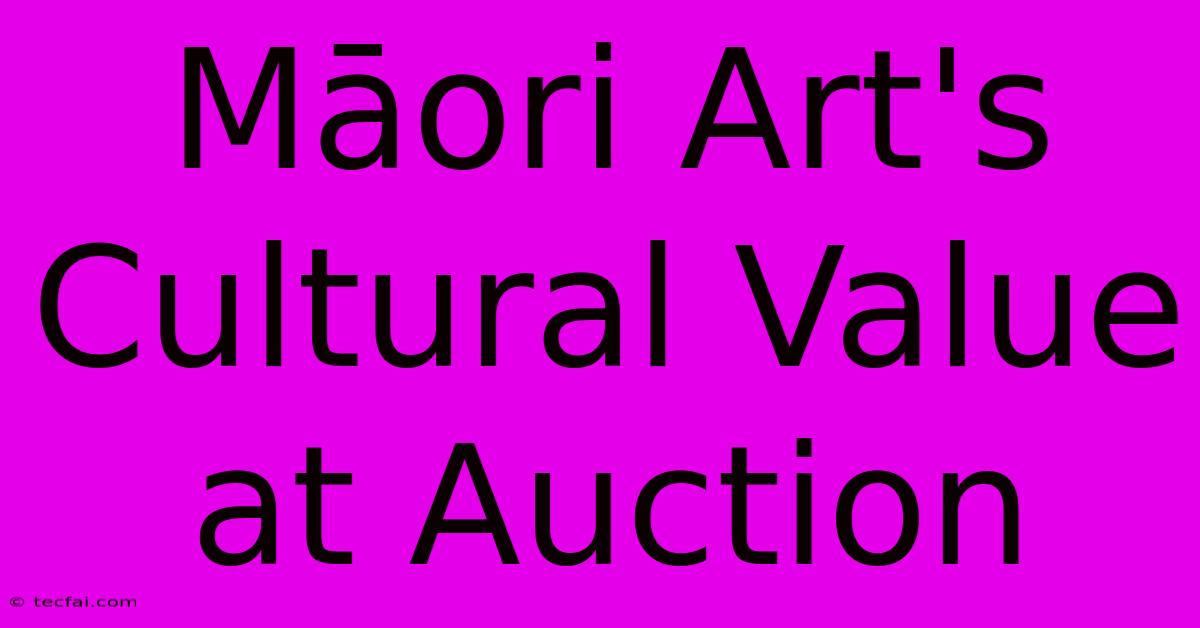Māori Art's Cultural Value At Auction

Discover more detailed and exciting information on our website. Click the link below to start your adventure: Visit Best Website tecfai.com. Don't miss out!
Table of Contents
Māori Art's Cultural Value at Auction: A Complex Tapestry of Heritage and Market Forces
Māori art holds a unique position in the global art market. Its breathtaking beauty, intricate craftsmanship, and profound spiritual significance make it highly sought after by collectors worldwide. However, the auctioning of these taonga (treasures) presents a complex interplay between cultural value, monetary worth, and the inherent rights of Māori communities. Understanding this intricate tapestry is crucial to appreciating the nuances of the market and the ongoing efforts to protect Māori cultural heritage.
The Profound Cultural Significance of Māori Art
Before delving into the auction landscape, it's essential to grasp the profound cultural significance embedded within each piece. Māori art isn't merely decorative; it's a tangible expression of whakapapa (genealogy), mana (prestige), and tapu (sacredness). Carvings, weaving, and tattooing are imbued with narratives, ancestral histories, and spiritual power. A kōwhaiwhai pattern isn't just a decorative design; it's a visual representation of ancestral stories and spiritual connections. Similarly, a mere pounamu (greenstone weapon) isn't just an object; it embodies the strength and history of its owner and lineage.
Key Elements Contributing to Cultural Value:
- Whakapapa: The genealogical connections inherent in the artwork. Knowing the origin and history of a piece significantly impacts its cultural value.
- Mana: The prestige and authority associated with the artwork and its creator. Artworks passed down through generations accumulate mana.
- Tapu: The sacredness and spiritual power associated with the artwork. Some items possess a significant degree of tapu, requiring careful handling and respect.
- Materials: The materials used, such as pounamu (greenstone), kawakawa (a native plant), and feathers, hold cultural significance.
- Crafting Techniques: The specific techniques used in creating the art reflect traditional knowledge and skill passed down through generations.
Navigating the Auction World: Challenges and Considerations
The auctioning of Māori art presents several significant challenges. The primary concern is the potential for alienation of taonga from their rightful owners and custodians. While auctions can provide access to significant funds for communities, the risk of losing irreplaceable cultural heritage remains a constant worry.
Ethical Considerations for Collectors and Auction Houses:
- Provenance: Thorough investigation into the provenance (history of ownership) of any Māori artwork is paramount. Purchasing art with unclear provenance risks supporting illicit trade.
- Repatriation Efforts: Supporting repatriation initiatives aimed at returning taonga to their rightful owners or communities is a moral imperative.
- Cultural Sensitivity: Respect for Māori protocols and customary practices is crucial throughout the process.
- Transparency: Openness and transparency in the auction process regarding provenance, cultural significance, and ethical sourcing are vital for building trust.
Balancing Cultural Preservation with Market Forces
The conflict between the immense cultural value of Māori art and the economic realities of the art market necessitates a delicate balancing act. The growing awareness of the cultural sensitivities involved is encouraging positive changes, with more auction houses implementing stricter guidelines and consulting with Māori experts.
Strategies for Ethical Engagement:
- Collaboration with Māori Communities: Auction houses and collectors should actively engage with Māori communities to ensure respect for cultural protocols and the protection of taonga.
- Educational Initiatives: Raising awareness among collectors and the wider public about the cultural significance of Māori art and the ethical considerations surrounding its sale is essential.
- Strengthening Legal Frameworks: Robust legal frameworks are needed to protect Māori cultural heritage and regulate the trade in taonga.
The Future of Māori Art in the Auction World
The future of Māori art within the auction system hinges on ongoing dialogue and collaboration. By prioritizing ethical practices, transparency, and respect for Māori cultural values, the art market can contribute to the preservation of this precious heritage rather than its erosion. The journey is ongoing, but a more responsible and culturally sensitive approach is slowly emerging, offering hope for the future of these priceless taonga.

Thank you for visiting our website wich cover about Māori Art's Cultural Value At Auction. We hope the information provided has been useful to you. Feel free to contact us if you have any questions or need further assistance. See you next time and dont miss to bookmark.
Featured Posts
-
Rebuilt Notre Dame A Post Fire Update
Nov 30, 2024
-
Southampton Brighton 1 1 Wedstrydverslag
Nov 30, 2024
-
Oregon State Football Game Time Channel
Nov 30, 2024
-
Ikkys I Like You Featuring Soni Pabla
Nov 30, 2024
-
Sharks Triomfeer Oor Stormers In Urc
Nov 30, 2024
